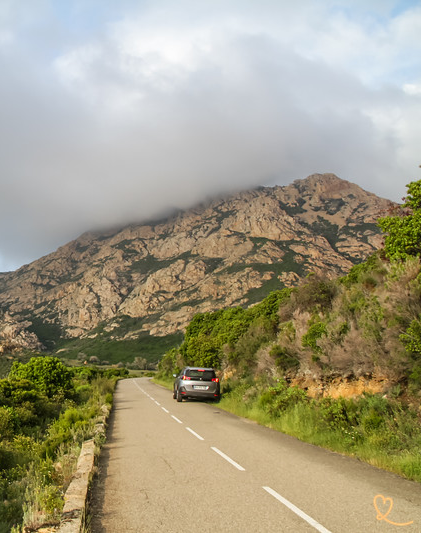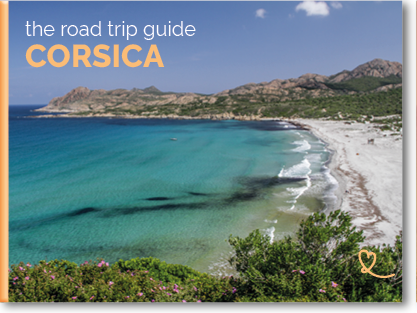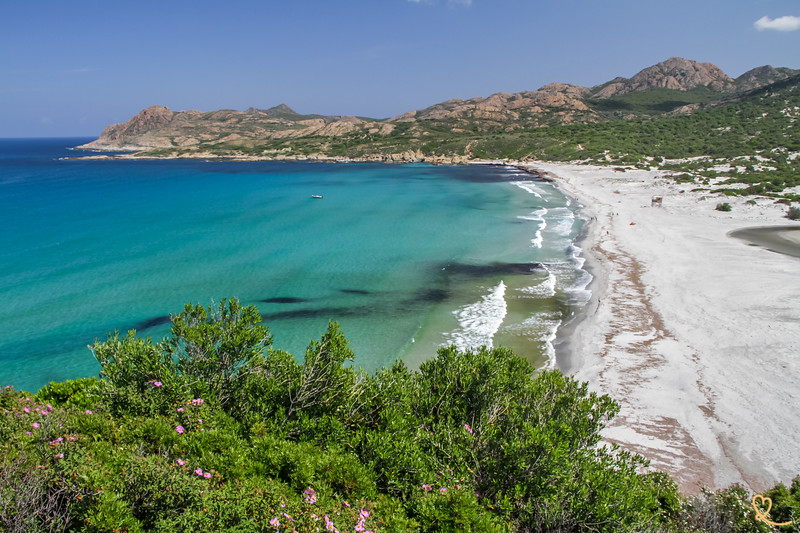Visiting Bastia? Don’t miss Saint-Jean-Baptiste Church! Built in the 17th century, the church overlooking the harbor has become one of Bastia’s most emblematic landmarks. Behind the soberly elegant ochre façade lies an interior of breathtaking Baroque richness.
In this article, you’ll find some useful tips to help you prepare for your visit and have a wonderful time!

This guide is completely independent, based on our experiences. We visited the region anonymously, making our own choices and paying our bills in full.
Why visit Bastia’s Saint-Jean-Baptiste church?
Is Saint-Jean-Baptiste Church worth it? Our opinion:
Yes, the church is well worth a visit. From the moment you step outside, you’ll be captivated by its silhouette overlooking the port of Bastia! Inside, you’ll be amazed by the baroque architectural details and remarkable works of art.
For us, it’s one of the best activities in Bastia.

Why is Saint-Jean-Baptiste Church famous?
The Saint-Jean-Baptiste church is famous for being the largest church in Corsica!
In addition to its size, it is also impressive for the richness of its ornamentation and its magnificent pieces of sacred art.
It also plays a central role in St. John’s Day festivities in June.

Our favorite moment
At the heart of the building, the central vault in particular caught our attention.
The scene of Christ’s Baptism is set off by delicate gilded stucco and gypsum work, bathed in natural light from the high windows that illuminate all the paintings.

History in brief
Here are the key dates for Saint-Jean-Baptiste church:
- 1636-1666: Construction of the church on the site of a former chapel
- 1693: Marble high altar by Marseille sculptor Honoré Pellé in Genoa
- 1742: Construction of the organ gallery by Giovan Battista Terrigo, master carpenter from Bastia
- 1779-1781: Creation and installation of the polychrome marble pulpit by Gaetano and Gian Andrea Torre
- 1810: Construction of the left bell tower by Swiss master mason Tomaso Quadri
- 1864: Completion of the facade by Paul-Augustin Viale (triangular pediment and straight bell tower).
- 2000: Listed as a Historical Monument

Access: Saint-Jean-Baptiste church, Bastia
Where is Saint-Jean-Baptiste church?
- In downtown Bastia, at 4 Rue Cardinal Viale Prelà
- It can be seen from the Old Port
Note that the entrance is via the Place du Marché, not the pediment.

OUR TIPS FOR RENTING A CAR IN Corsica
- Compare prices on our preferred platform: DiscoverCars – one of the best rated sites.
- Choose a car that is powerful enough (the roads are steep) but compact (some passages are narrow).
- Think of thecomplete insurance (some roads are tortuous and narrow).
- There is a lot of demand, book it early.

How to get there?
The church is easily accessible from several points in the city. You can reach it on foot from the Port of Bastia in 15 minutes or from the train station in 10 minutes.
The city’s atmosphere of dolce vita is sure to please strollers on foot!
For those who prefer public transport, several bus lines (11, 15, 17, 20 and 33) serve the site.

Parking
The Place du Marché parking lot is just a 1-minute walk from the church, offering a convenient solution for parking your vehicle.
THINGS TO DO AROUND Bastia
Discover all our articles on the region:
Useful tips: duration, schedules, eating…
Best time to visit
We recommend an early morning visit, between 8:30 and 10 a.m., when the morning light sublimates the ochre facade. We particularly enjoyed the sunlight streaming through the stained glass windows in the late afternoon, creating a unique atmosphere. For greater peace and quiet, avoid times of religious celebration and prefer periods out of the tourist season, especially July and August.

Length of visit and main difficulties
Allow around 30min to explore the church. The floor is not particularly difficult, making for a comfortable visit.
Advice on how to visit
You can visit the church at your leisure. However, we recommend that you take a look at the exterior before exploring the treasures inside.

USE OUR GUIDE TO PLAN A
DREAM TRIP TO Corsica
All the information you need for your trip:
- 7 maps that make planning easier
- 130+ pre-selected locations
- Practical advice
- + 220 photos to help you choose

Visiting with children
The visit is not particularly suitable for children, but can be an opportunity to introduce them to an important part of Corsican history.
Schedules and rates
The church is open Monday to Friday, 8:30am to 12:30pm and 1:30pm to 6:00pm. Admission is free.
Subscribe to our Newsletter
- Get away from it all with Region Lovers’ beautiful destinations!
- Once a month
- Advertising-free
An emblematic church at the Bastia Citadel
A sober 17th-century façade
The current facade, rebuilt in the 1860s by Augustin Viale, features Jesuit-style architecture with three bays topped by a pediment and framed by two bell towers. We really liked the warm yellow color of the building, which contrasts with the sobriety of the whole. Access is via an east-facing chapel, harmoniously integrated into the architectural ensemble.

A Baroque interior
The interior layout of the church reveals a complex and refined architecture.
We were struck by the sheer size of the single nave, extended by a very deep choir and enriched by three interconnecting side chapels.
Take a look at the side aisles, alternating barrel and rib vaults.
We were fascinated by the intermingling of rooms, the diversity of materials used and the omnipresence of stucco and gilding, characteristic of Baroque decoration.

Among the chapels, we particularly liked the poetic sailors’ chapel, with its wealth of detail, from the altar to the vaulting, columns and stained glass windows. And don’t miss the baptismal font chapel, adorned with magnificent marble sculptures by Ferdinando Pellicciaqui.

A profusion of details
Pay close attention, as a multitude of ornamental details lurk in every nook and cranny of the church. Note, for example, the finely sculpted cherub heads in the various chapels, or the polychrome marble altar in the fishermen’s chapel.

On the marble high altar, commissioned in Genoa in 1693 from Marseille-born sculptor Honoré Pellé, you’ll find a silver tabernacle chased in the 19th century by Sienese silversmith Gaetano Macchi.

A showcase for sacred art
The organ loft
The organ loft is one of the jewels in the church’s crown. Built in 1742 by Bastia’s master carpenter Giovan Battista Terrigo, its bold curves and imposing dimensions evoke the stern of a Baroque galleon.

Paintings
Take time to observe the various paintings that dot the church. Look up and see the work adorning the central medallion of the church vault. This depiction of the Baptism of Christ is striking for its soft colors and delicate composition.

The side altars are adorned with Baroque paintings, mainly by the Genoese school, with major works by Domenico Piola, Giovanni Raffaele Badaracco and Lorenzo De Ferrari. We were seduced by the variety of subjects and the harmony that emanates from this remarkable pictorial ensemble.

The pulpit
The pulpit is considered the most valuable in Corsica.
We marveled at the finesse of its execution in white marble, sublimated by inlays of Sicilian diapre, Sienna yellow and Polcevera green. Commissioned in Genoa in 1779, it was created by sculptors Gaetano and Gian Andrea Torre, father and son, and painstakingly assembled on site in 1781.
Did you notice the dove sculpture hanging from the lampshade? Another of this church’s most charming details…

Frequently asked questions
What is Saint John’s Day in Bastia?
Saint John’s Day is a traditional celebration that takes place on June 24. It’s a very important festival in Corsican tradition, marking the summer solstice.
On the evening of June 23, a huge blaze was lit under the ramparts of the Citadelle on the edge of the Vieux Port basin. This fire festival is accompanied by the rite of the first sea bath, which, according to tradition, has regenerative properties…
For more information, visit the official website here.
PLAN YOUR TRIP TO Corsica
Inspiration destinations

Best of
- The most beautiful beaches of Corsica
- The most beautiful villages of Corsica
- The most beautiful cities of Corsica
- The most beautiful destinations in Corsica
- The museums of Corsica
- Hidden gems in Corsica
- The most beautiful natural pools
- What to do in North Corsica
- Best things to do in South Corsica
- Canyoning in Corsica

Where to stay





